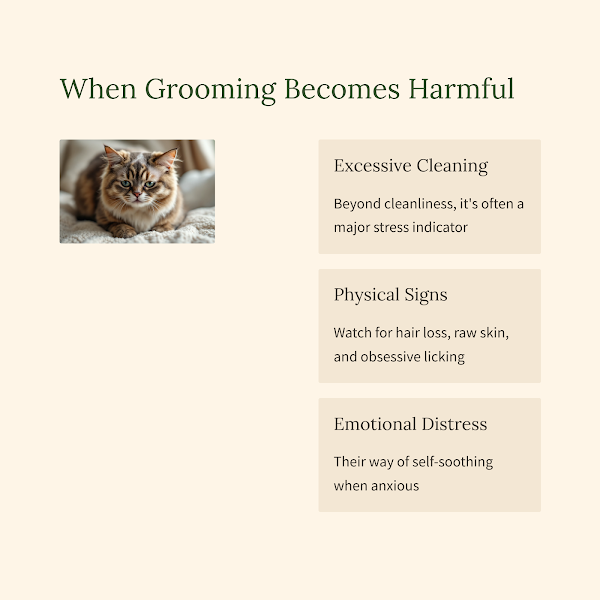Your Cat’s Stress Isn’t Cute—It’s a Red Flag
Hello~ Everyone,
Today I'm talking about cat stress signals that many people misinterpret as cute behaviors! I have some useful information for you guys~ Shall we find out right away?^^
Have you ever thought your cat's behaviors were adorable when they were actually showing signs of stress? Many cat parents unknowingly mistake anxiety signals for cuteness.
This misunderstanding can lead to prolonged stress for our feline friends, which eventually impacts their physical and mental health.
Let's learn to identify these signals correctly and help our furry companions live happier, healthier lives!
| Stress vs. Cuteness | Health Implications |
| What appears "shy" or "cute" might actually be fear or anxiety | Chronic stress can lead to digestive issues and weakened immunity |
| Ears flat against head isn't "being coy" - it's fear | Stressed cats often develop urinary tract infections |
| Excessive grooming isn't just "being clean" - can indicate anxiety | Stress can trigger or worsen skin conditions |
😿 Common Stress Behaviors Mistaken as Cute
When your cat hides under furniture or in small spaces frequently, it's not just being "shy" or "playful." This is actually a defensive behavior indicating they don't feel safe in their environment.
Many cat owners think excessive grooming means their cat is exceptionally clean, but when cats groom to the point of creating bald spots, it's a serious stress response similar to human nail-biting.
That adorable "airplane ear" position where their ears flatten against their head? That's your cat's way of expressing fear or anxiety, not being cute or coy.
🙀 Physical Signs Your Cat is Actually Stressed
Dilated pupils in normal lighting conditions can be mistaken for playfulness or excitement, but they often signal that your cat is in a state of fear or stress.
When cats exhibit a tucked tail or puffed fur, they're not just being expressive - these are clear physical manifestations of stress and discomfort.
Excessive vocalization isn't just your cat being "chatty" - persistent meowing can indicate anxiety, discomfort, or unmet needs that require your attention.
🏠 Environmental Factors Causing Cat Stress
Changes in the home environment can severely impact your cat's sense of security. New furniture, rearranged rooms, or even new scents can trigger stress responses.
Visitors or new household members (including other pets) can make cats feel territorially threatened, leading to behaviors often misinterpreted as shyness or cuteness.
Loud noises from construction, music, or household appliances can create significant stress for cats, whose hearing is much more sensitive than ours.
🩺 Health Consequences of Chronic Stress
Long-term stress in cats can manifest as serious health problems including urinary tract infections, digestive issues, and compromised immune systems.
Chronic stress has been linked to feline idiopathic cystitis, a painful bladder condition that can become life-threatening if not addressed.
Behavioral issues like inappropriate elimination aren't your cat being "spiteful" - they're often direct responses to stress and anxiety that require compassionate intervention.
🧠 How to Help Your Stressed Cat
Creating predictable routines helps cats feel secure. Try to feed, play, and clean litter boxes at consistent times each day to reduce environmental stress.
Provide multiple safe retreats throughout your home where your cat can escape when feeling overwhelmed. Vertical spaces, hiding spots, and quiet areas are essential for feline mental health.
Consider pheromone diffusers like Feliway that mimic natural cat calming signals, helping to reduce anxiety in many household situations.
| Body Language | Behavioral Signs | Environmental Factors |
| Flattened ears | Excessive grooming | New furniture |
| Dilated pupils | Hiding behavior | Loud noises |
| Puffed tail | Increased vocalization | New household members |
| Tense posture | Inappropriate elimination | Schedule changes |
Understanding the difference between stress behaviors and genuine happy behaviors is crucial for providing proper care for your cat.
Happy cats have relaxed body postures, forward-facing ears, slow blinking eyes, and gentle purring - these are the true signs of feline contentment you should look for.
If you notice persistent stress behaviors, consulting with a veterinarian or feline behaviorist can help identify underlying issues and develop appropriate interventions.
| Is my cat stressed if it hides when guests come over? | Yes, hiding during visits is often a stress response to unfamiliar people. Create a safe room where your cat can retreat during social gatherings. |
| Can playing more with my cat reduce its stress? | Absolutely! Regular interactive play sessions help release tension, provide mental stimulation, and strengthen your bond, all of which reduce stress. |
| Should I take my stressed cat to the vet? | If you notice sudden or persistent stress behaviors, a veterinary check is recommended as stress can be a symptom of underlying medical conditions. |
Learning to recognize and address your cat's stress signals isn't just good pet parenting—it's essential for their wellbeing. By understanding what your cat is really communicating, you can create an environment where they truly thrive.
Remember, a genuinely happy cat isn't hiding, flattening their ears, or excessively grooming—they're confidently exploring, playing, and showing relaxed body language.
See you next time with another helpful topic about our beloved feline friends! 😺 Bye Bye~







Comments
Post a Comment